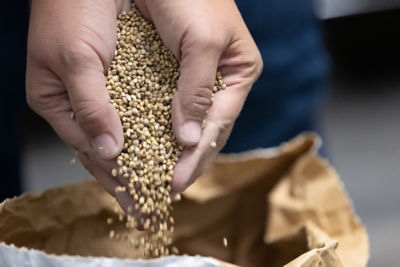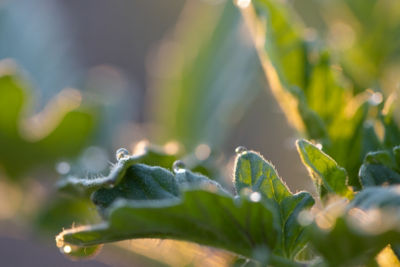Click here to download a PDF version of this spotlight.
» Squash bugs have become an increasingly important pest of watermelon in recent years.
» Squash bugs feed on the leaves and fruit of cucurbit plants, resulting in a loss of yield and quality.
» Integrated use of cultural and chemical control strategies can help manage squash bugs on watermelon.
The squash bug, Anasa tristis, is an endemic pest of cucurbits throughout North America, from southern Canada through Central America.1,2 Squash bugs feed on many cucurbit species, and in the past, were primarily a problem on summer squash and pumpkin. However, they have recently become problematic on watermelon, possibly because of changes in pesticide use and production practices. Squash bugs also transmit a bacterial disease of cucurbits, cucurbit yellow vine disease (CYVD), that is somewhat new in North America.1,2,3,4
IDENTIFICATION
Adult squash bugs are 1/2 to 2/3 inch long, with flat wings held over the back of the body when at rest (Figure 1A). They are brownish yellow but can appear dark brown to black because of the presence of black hairs covering the body. The margins of the abdomen can appear orange or orange/brown striped. The adults can emit an unpleasant odor, when disturbed.1,2,3,4 Female squash bugs lay eggs on cucurbit leaves, typically on the underside in tight clusters of 15 to 40, often forming an angular pattern. The eggs are oval and initially off-white but turn a dark, shiny, coppery brown over time (Figure 1B).2,3,4
There are five nymph stages (instars). Initially, nymphs are ⅛ inch long, wingless, and pale green to reddish. Later instars develop a blackish thorax and brown abdomen but often appear gray with black legs and antennae because their bodies are covered with a white powder (Figure 1C).1,3,4

DAMAGE
Adults and nymphs cause damage to plants when sucking plant sap from leaves and fruit using their piercing-sucking mouth parts. The damage comes primarily from a physical disruption of tissue. It was thought that squash bug saliva was toxic and killed tissue when injected through the stylet (feeding tube). However, that assertion is now in dispute.1,2,4
Damaged leaves become speckled as a result of a loss of water and nutrients. Over time, the leaves wilt, become blackened, and die. Plants in the two to four-leaf stages can quickly collapse and die from moderate squash bug feeding. On larger plants, entire plants or individual vines can wilt and die (Figure 2). The amount of damage is usually proportional to the number of feeding squash bugs.1,2,3,4 Adults and nymphs can also feed on fruit, resulting in scarring, blemishes, and collapse. Affected fruit can show increased levels of rotting in storage. Plant growth and flower productivity are often reduced on affected plants, and yield reductions of over 50% have been documented in untreated research plots.2,3,4
The bacterial pathogen that causes cucurbit yellow vine disease (CYVD) overwinters in adult squash bugs and is transmitted to cucurbit plants when the insects feed.1
 Figure 2. Foliar symptoms resulting from squash bug feeding on watermelon. Alton N. Sparks, Jr., University of Georgia. Bugwood.org.
Figure 2. Foliar symptoms resulting from squash bug feeding on watermelon. Alton N. Sparks, Jr., University of Georgia. Bugwood.org.
LIFE CYCLE
The squash bug life cycle is completed, egg to adult, in six to eight weeks. One brood (generation) per year is usually seen in cooler, northern areas, while two to three broods per year can occur in warmer regions.1,2,3 The insect overwinters as adults in protected areas, such as under crop debris and leaf litter, in wood piles, and in buildings. Adults become active in the spring, usually after the emergence of host plants. Cooler temperatures in the spring can result in delayed emergence of adult squash bugs.
Upon emergence from overwintering, adults seek out cucurbit plants on which to feed. Females can start laying eggs seven to ten days after emergence, and eggs usually hatch one to three weeks after deposition. The development of nymphs through the five instars often takes about 33 days. Initially, the nymphs are gregarious, occurring in large groups, but become more solitary as they mature. Adults and older nymphs are often found near the base of the plant and try to remain hidden, especially during the day. Adults can live up to 130 days.1,2,3
MANAGEMENT
Squash bugs are not often problem for large-scale watermelon operations because of the lack of overwintering sites in well-managed fields. However, this insect can cause considerable yield reductions in smaller fields. The management of squash bugs is especially challenging in organic production systems due to the lack of availability of effective insecticides and the increased number of overwintering sites associated with organic mulches and higher levels of ground cover.1,2
Cultural management includes the removal of plant debris, weeds, and organic mulch after harvest to reduce the number of overwintering sites. Crop rotation may help reduce infestations but should include the elimination of volunteer and weed hosts such wild Cucurbita species. Early planting can help reduce feeding levels on young plants. Row covers can also protect plants from squash bugs early in the season, but plants can quickly become colonized when the row covers are removed as the plants begin to flower. One interesting strategy is based on the habit of squash bugs to hide under things during the day. If wooden boards are placed on the soil between plant rows, squash bugs will accumulate under them, and by stepping on the boards, the insects can be crushed.1,2,4
Early-planted summer squash and pumpkin plants are especially attractive to squash bugs and can be used as trap crops when planted around the main crop. Treating the trap crop with systemic insecticides can help lower populations of squash bugs in the main crop, but care should be taken to protect beneficial insects, such as pollinators.1,2,4 There are some natural enemies of squash bugs that can help lower populations, including wasp parasitoids, such as Gryon pennsylvanicum, and the orange-bodied tachinid fly, Trichopoda pennipes. Gryon pennsylvanicum parasitizes the eggs of squash bugs, and some studies have found that as much as 66% of squash bug eggs were parasitized by this species. Trichopoda pennipes parasitizes squash bug nymphs. It deposits eggs on late instar nymphs, and the emerging larva burrow into the nymph’s bodies. Twenty to thirty percent parasitism has been observed with this species. These and other parasitoids can help to lower the population of squash bugs in the planting.1,2 Providing habitats to attract these beneficial insects may help with squash bug management.
The primary strategy used for managing squash bugs on watermelon and other cucurbits is the application of insecticides. Scouting crops can be used to alert the grower when squash bugs are present and insecticide applications are warranted. Starting shortly after transplanting or seedling emergence, plants should be inspected for squash bug egg masses, and scouting should continue through the fruit development stage. For watermelon, an action threshold of one to two squash bugs or one egg mass per plant, on average, is suggested for initiating insecticide applications. However, in areas where CYDV is known to occur, preventative applications rather than applications based on sampling and thresholds are recommended.2,4
Squash bugs are difficult to kill with insecticides, especially the late instar nymph and adult stages. Earlier nymph stages are more susceptible to insecticide applications.1,2,4 Several insecticides are registered for controlling squash bugs on cucurbits, including watermelon.2,4,5 Foliar applications of pyrethroids and neonicotinoid insecticides have been shown to be effective for squash bug control; however, some of these insecticides may have negative effects on beneficial insects, including pollinators. Therefore, precautions should be taken to protect beneficial organisms when using products containing these active ingredients. Using insecticides with little residual activity can help protect pollinators from exposure, as can applying insecticides late in the day when honey bees are less active.1,2 Some neonicotinoids can be applied through a drip irrigation system to be taken up by the roots and systemically translocated in the plant. Such applications may help lessen the impact on beneficial insects.2
Consult regional vegetable production and pest management guides for lists of recommended, registered insecticides for managing squash bugs on watermelon and other cucurbit crops. Always read and follow the directions and restrictions listed on the most current pesticide label.4,5 Often using an IPM strategy, combining the use of chemical and cultural strategies, results in the most effective management of squash bug.2
SOURCES
1 Capinera, J. 2017. Featured Creatures: squash bug. UF IFAS Entomology & Nematology. Publication number EENY-77. https://entnemdept.ufl.edu/creatures/veg/leaf/squash_bug.htm.
2 Doughty, H., Wilson, J., Schultz, P., and Kuhar, T. 2016. Squash bug (Hemiptera: Coreidae): biology and management in cucurbitaceous crops. Journal of Integrated Pest Management, Volume 7, Issue 1, https://doi.org/10.1093/jipm/pmv024.
3 Squash bug. Field Guide to Common Texas Insects. https://texasinsects.tamu.edu/squash-bug/.
4 Natwick, E., Stapleton, J., Stoddard, C. 2016. Squash bug. Cucurbit UC IPM Pest Management Guidelines: Cucurbits. UC ANR Publication 3445.
5 Phillips, B., Nair, A., Bergefurd, B., Egel, D., Ingwell, L., and Meyers, S. 2023. Midwest vegetable production guide for commercial growers 2023. https://mwveguide.org/.
Websites verified on 4/26/2023
ADDITIONAL INFORMATION
For additional agronomic information, please contact your local seed representative.
Performance may vary from location to location and from year to year, as local growing, soil and weather conditions may vary. Growers should evaluate data from multiple locations and years whenever possible and should consider the impacts of these conditions on the grower’s fields. The recommendations in this article are based upon information obtained from the cited sources and should be used as a quick reference for information about vegetable production.
The content of this article should not be substituted for the professional opinion of a producer, grower, agronomist, pathologist and similar professional dealing with vegetable crops.
BAYER GROUP DOES NOT WARRANT THE ACCURACY OF ANY INFORMATION OR TECHNICAL ADVICE PROVIDED HEREIN AND DISCLAIMS ALL LIABILITY FOR ANY CLAIM INVOLVING SUCH INFORMATION OR ADVICE.
7015_236200 Published 05/18/2023




